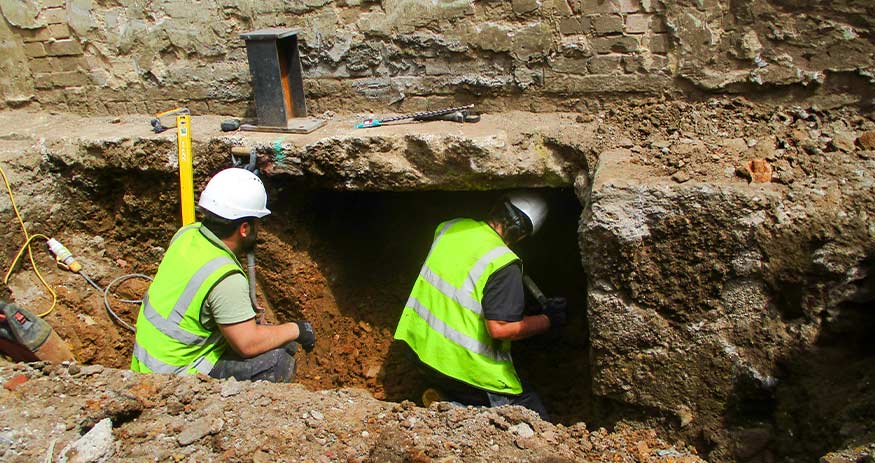
When it comes to your home’s structural integrity, what comes first? Usually, one of the biggest decisions you will be faced with is whether you will undertake underpinning or foundation repair. Although both methods are aimed at resolving foundation issues. However, the methods are quite different in terms of process, expense, and longevity. So, how do you determine what method would work the best for you?
For that you need to address the differences between underpinning and foundation repair. Here you will learn everything, including when to apply each method, their cost, and consulting with experts. So, let’s begin with the basics.
Underpinning a building is a process of either strengthening or stabilizing a building’s foundation. Even if you want to structure by extending the foundation below the existing foundation down to a stronger level. This process is typically used when a building’s existing foundation is unstable because of soil movement, settling, etc.
Underpinning often involves digging beneath the existing foundation to provide additional support; this can also be done in a number of different ways such as concrete piers, steel beams, and helical piles.
Underpinning is usually the best choice for underpinning when:
The soil below the foundation has shifted: If the soil underneath a foundation has become unstable or eroded over time, underpinning helps stabilize the structure even further.
The existing foundation has settled or cracked: Homeowners may not take the cracking or settling of the foundation too seriously. However, the settling of the foundation may seriously impair the structural integrity of the home. Underpinning can help provide a permanent solution to the problem.
Expanding or modifying an existing building: If you plan on adding floors or more levels to your home, underpinning may be advised and sometimes required to further assure that the site is adequately supported once the former structure is expanded.
Underpinning involves digging small amounts of soil out from under the building’s foundation, enhancing the soil with concrete or steel piles, and then the new weight of the building can be redistributed onto the piles, which helps stabilize the site. To learn more about why this process is essential, check out this detailed article on the importance of basement underpinning.
Conversely, foundation repair is generally used to describe minor foundation problems, such as a small crack where the foundation has shifted or has been damaged by water. Unlike underpinning, repairs of the foundation do not usually require digging deep into the ground or changing the structure of the underlying foundation. Some of the more common repair methods can include:
The processes we discussed included the following:
Typically, a foundation repair is warranted when:
There are small cracks or leaks in the foundation: Generally, small cracks in the wall or foundation can be repaired without having to lengthen the foundation.
There is slight foundation settlement: If the foundation has settled unevenly but there is no sever structural failure, then it likely just needs some stabilization via small interventions.
There is waterproofing: If there is moisture leaking through the foundation but the building is sound, then work at the foundation may involve sealing and waterproofing and not portending.
Now that we have covered what each of the major repairs entails, let us compare and contrast both terms.
| Factor | Underpinning | Foundation Repair |
| Purpose | Strengthens and stabilizes foundation | Repairs cracks, leveling, and sealing |
| Depth | Deep excavation to extend foundation | Surface-level or shallow intervention |
| Cost | More expensive due to labor and materials | Generally more affordable |
| Duration | Longer process (weeks or months) | Shorter process (days or weeks) |
| Long-Term Effectiveness | Permanent solution | Effective but may require follow-up |
Typically, underpinning is more expensive and takes longer but it offers a more lasting solution for extensive foundation problems. Foundation repair is usually cheaper and quicker but when addressing larger foundation issues it may not permanently solve the true cause of the problem.
The choice between underpinning and foundation repair will depend on many factors, including how extensive the damage is, what is causing it, your budget and your long-term goals.
The decision of underpinning or foundation repair must be qualified by a professional assessment. A professional will inspect your foundation, discover the reasons for the problem, and give you options for solutions. Remember, when considering any underpinning or foundation repair, be sure to consult a qualified professional contractor.
If you are looking for foundation services, call Rock Bottom Underpinning. Call their experienced team to assess your home’s foundation condition and provide you with professional options, which will help you provide a stable home for years to come.
1 – What is the difference between underpinning and foundation repair?
Underpinning is deep excavation and adding new support to a foundation, in contrast to foundation repair which is generally dealing with the surface issues of your foundation such as crack filling, or levelling the foundation.
2 – Is underpinning or foundation repair more expensive?
Underpinning is usually more expensive to repair because it involves a lot more work; deep excavation, and putting in new foundation support. Foundation repair usually costs less because it is typically repairing small minor issues.
3 – How long does underpinning take?
Underpinning is a very labour-intensive job that usually takes weeks, if not months depending on what is involved in the job. Foundation repair is usually done quite quickly.
4 – Do I need a professional to fix my foundation or can I do it myself?
Fixing a foundation can be complicated and will involve specialized equipment and experience. It is always advisable to hire a contractor like Rock Bottom Underpinning, who will be